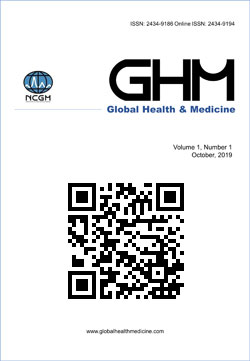Volume 3, Issue 6
Displaying 1-11 of 11 articles from this issue
- |<
- <
- 1
- >
- >|
Editorial
-
Article type: editorial
2021 Volume 3 Issue 6 Pages 356-357
Published: December 31, 2021
Released on J-STAGE: January 05, 2022
Advance online publication: November 14, 2021Download PDF (161K)
Review
-
Article type: review-article
2021 Volume 3 Issue 6 Pages 358-364
Published: December 31, 2021
Released on J-STAGE: January 05, 2022
Advance online publication: September 16, 2021Download PDF (1079K) -
Article type: review-article
2021 Volume 3 Issue 6 Pages 365-370
Published: December 31, 2021
Released on J-STAGE: January 05, 2022
Advance online publication: September 05, 2021Download PDF (432K) -
Article type: review-article
2021 Volume 3 Issue 6 Pages 371-377
Published: December 31, 2021
Released on J-STAGE: January 05, 2022
Advance online publication: May 16, 2021Download PDF (1575K) -
Article type: review-article
2021 Volume 3 Issue 6 Pages 378-385
Published: December 31, 2021
Released on J-STAGE: January 05, 2022
Advance online publication: July 24, 2021Download PDF (701K) -
Article type: review-article
2021 Volume 3 Issue 6 Pages 386-393
Published: December 31, 2021
Released on J-STAGE: January 05, 2022
Advance online publication: July 18, 2021Download PDF (296K)
Original Article
-
Article type: research-article
2021 Volume 3 Issue 6 Pages 394-400
Published: December 31, 2021
Released on J-STAGE: January 05, 2022
Advance online publication: November 14, 2021Download PDF (978K)
Perspective
-
2021 Volume 3 Issue 6 Pages 401-405
Published: December 31, 2021
Released on J-STAGE: January 05, 2022
Advance online publication: September 05, 2021Download PDF (647K)
Communication
-
2021 Volume 3 Issue 6 Pages 406-408
Published: December 31, 2021
Released on J-STAGE: January 05, 2022
Advance online publication: June 01, 2021Download PDF (1008K) -
2021 Volume 3 Issue 6 Pages 409-412
Published: December 31, 2021
Released on J-STAGE: January 05, 2022
Advance online publication: July 29, 2021Download PDF (267K)
News
-
Article type: news
2021 Volume 3 Issue 6 Pages 413-414
Published: December 31, 2021
Released on J-STAGE: January 05, 2022
Advance online publication: December 16, 2021Download PDF (373K)
- |<
- <
- 1
- >
- >|
